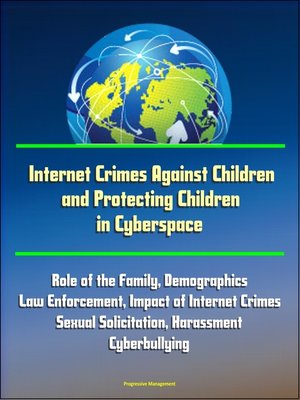Internet Crimes Against Children and Protecting Children in Cyberspace
ebook ∣ Role of the Family, Demographics, Law Enforcement, Impact of Internet Crimes, Sexual Solicitation, Harassment, Cyberbullying

Sign up to save your library
With an OverDrive account, you can save your favorite libraries for at-a-glance information about availability. Find out more about OverDrive accounts.
Find this title in Libby, the library reading app by OverDrive.



Search for a digital library with this title
Title found at these libraries:
| Loading... |
Children have always been vulnerable to victimization. Their trusting natures and naivete make them perfect targets for perpetrators—both people they know and those they don't. As children grow into adolescents, they remain vulnerable to victimization. Youth are often curious and eager to try new things. Many youth struggle with issues of rebellion and independence and seek attention and affection from people outside the home, often by using computers. With so many children online, today's predators can easily find and exploit them. For predators, the Internet is a new, effective, and more anonymous way to seek out and groom children for criminal purposes such as producing and distributing child pornography, contacting and stalking children for the purpose of engaging in sexual acts, and exploiting children for sexual tourism for personal and commercial purposes. The nature of Internet crimes presents complex new challenges for law enforcement agencies and victim service providers with regard to investigating crimes, collecting evidence, identifying and apprehending offenders, and assisting child victims and their families. For example, victims and perpetrators are often separated geographically, which may hamper investigation efforts. Also, victims are often ashamed and reluctant to come forward, which makes identifying offenders difficult. These challenges are being addressed by federal and local law enforcement agencies, but there is still much to learn about preventing, identifying, and investigating Internet-based crimes against children.Unfortunately, cyberspace is not always a safe place for youngsters to visit. Some sex offenders use the privacy and anonymity of the Internet to prey on vulnerable children and teenagers, whose Internet access is often unsupervised. In exchanging child pornography or seeking victims online, sex offenders may face little risk of interdiction of their criminal activities.To combat computer-facilitated sex crimes, the Office of Juvenile Justice and Delinquency Prevention funds the Internet Crimes Against Children (ICAC) Task Force Program, which protects children in cyberspace. Although apprehending sex offenders who use the Internet to facilitate their crimes presents significant challenges, the ICAC Program can help State and local law enforcement agencies to develop an effective response to online enticement and child pornography cases. Included in this response are community education, forensic, investigative, and victim service components. We encourage parents, policymakers, and practitioners to use the information provided by this Bulletin to help create an Internet environment in which children can safely play, learn, and grow. With remarkable foresight, William Gibson, in his 1984 novel Neuromancer, predicted that society's increasing reliance on computers and information technology would create an electronic virtual universe that he called Cyberspace. Seventeen years later, cyberspace has become much more than a premise in a science fiction novel—it is the equivalent of a gold-rush boomtown. Every second, six new people sign on to the Internet, which, with astonishing speed, has become commonplace in daily life and increasingly vital to learning and communication.






